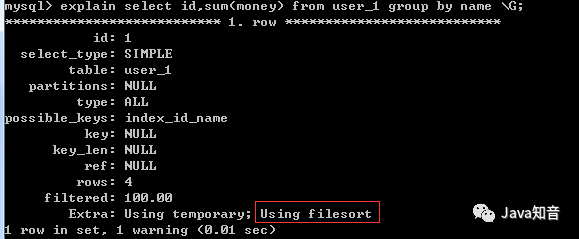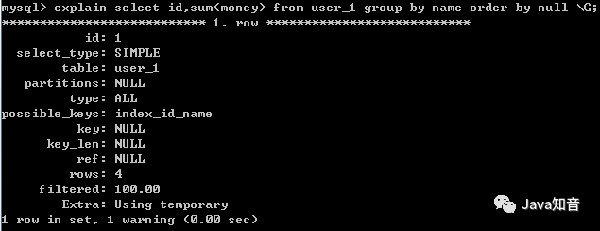您好,登錄后才能下訂單哦!
您好,登錄后才能下訂單哦!
本篇文章給大家分享的是有關開發中那些常用的MySQL優化有哪些,小編覺得挺實用的,因此分享給大家學習,希望大家閱讀完這篇文章后可以有所收獲,話不多說,跟著小編一起來看看吧。
1、大批量插入數據優化
(1)對于MyISAM存儲引擎的表,可以使用:DISABLE KEYS 和 ENABLE KEYS 用來打開或者關閉 MyISAM 表非唯一索引的更新。
ALTER TABLE tbl_name DISABLE KEYS; loading the data ALTER TABLE tbl_name ENABLE KEYS;
(2)對于InnoDB引擎,有以下幾種優化措施:
① 導入的數據按照主鍵的順序保存:這是因為InnoDB引擎表示按照主鍵順序保存的,如果能將插入的數據提前按照排序好自然能省去很多時間。
比如bulk_insert.txt文件是以表user主鍵的順序存儲的,導入的時間為15.23秒
mysql> load data infile 'mysql/bulk_insert.txt' into table user; Query OK, 126732 rows affected (15.23 sec) Records: 126732 Deleted: 0 Skipped: 0 Warnings: 0
沒有按照主鍵排序的話,時間為:26.54秒
mysql> load data infile 'mysql/bulk_insert.txt' into table user; Query OK, 126732 rows affected (26.54 sec) Records: 126732 Deleted: 0 Skipped: 0 Warnings: 0
② 導入數據前執行SET UNIQUE_CHECKS=0,關閉唯一性校驗,帶導入之后再打開設置為1:校驗會消耗時間,在數據量大的情況下需要考慮。
③ 導入前設置SET AUTOCOMMIT=0,關閉自動提交,導入后結束再設置為1:這是因為自動提交會消耗部分時間與資源,雖然消耗不是很大,但是在數據量大的情況下還是得考慮。
2、INSERT的優化
(1)盡量使用多個值表的 INSERT 語句,這種方式將大大縮減客戶端與數據庫之間的連接、關閉等消耗。(同一客戶的情況下),即:
INSERT INTO tablename values(1,2),(1,3),(1,4)
實驗:插入8條數據到user表中(使用navicat客戶端工具)
insert into user values(1,'test',replace(uuid(),'-','')); insert into user values(2,'test',replace(uuid(),'-','')); insert into user values(3,'test',replace(uuid(),'-','')); insert into user values(4,'test',replace(uuid(),'-','')); insert into user values(5,'test',replace(uuid(),'-','')); insert into user values(6,'test',replace(uuid(),'-','')); insert into user values(7,'test',replace(uuid(),'-','')); insert into user values(8,'test',replace(uuid(),'-',''));
得到反饋:
[SQL] insert into user values(1,'test',replace(uuid(),'-','')); 受影響的行: 1 時間: 0.033s [SQL] insert into user values(2,'test',replace(uuid(),'-','')); 受影響的行: 1 時間: 0.034s [SQL] insert into user values(3,'test',replace(uuid(),'-','')); 受影響的行: 1 時間: 0.056s [SQL] insert into user values(4,'test',replace(uuid(),'-','')); 受影響的行: 1 時間: 0.008s [SQL] insert into user values(5,'test',replace(uuid(),'-','')); 受影響的行: 1 時間: 0.008s [SQL] insert into user values(6,'test',replace(uuid(),'-','')); 受影響的行: 1 時間: 0.024s [SQL] insert into user values(7,'test',replace(uuid(),'-','')); 受影響的行: 1 時間: 0.004s [SQL] insert into user values(8,'test',replace(uuid(),'-','')); 受影響的行: 1 時間: 0.004s
總共的時間為0.171秒,接下來使用多值表形式:
insert into user values (9,'test',replace(uuid(),'-','')), (10,'test',replace(uuid(),'-','')), (11,'test',replace(uuid(),'-','')), (12,'test',replace(uuid(),'-','')), (13,'test',replace(uuid(),'-','')), (14,'test',replace(uuid(),'-','')), (15,'test',replace(uuid(),'-','')), (16,'test',replace(uuid(),'-',''));
得到反饋:
[SQL] insert into user values (9,'test',replace(uuid(),'-','')), (10,'test',replace(uuid(),'-','')), (11,'test',replace(uuid(),'-','')), (12,'test',replace(uuid(),'-','')), (13,'test',replace(uuid(),'-','')), (14,'test',replace(uuid(),'-','')), (15,'test',replace(uuid(),'-','')), (16,'test',replace(uuid(),'-','')); 受影響的行: 8 時間: 0.038s
得到時間為0.038,這樣一來可以很明顯節約時間優化SQL
(2)如果在不同客戶端插入很多行,可使用INSERT DELAYED語句得到更高的速度,DELLAYED含義是讓INSERT語句馬上執行,其實數據都被放在內存的隊列中。并沒有真正寫入磁盤。LOW_PRIORITY剛好相反。
(3)將索引文件和數據文件分在不同的磁盤上存放(InnoDB引擎是在同一個表空間的)。
(4)如果批量插入,則可以增加bluk_insert_buffer_size變量值提供速度(只對MyISAM有用)
(5)當從一個文本文件裝載一個表時,使用LOAD DATA INFILE,通常比INSERT語句快20倍。
3、GROUP BY的優化
在默認情況下,MySQL中的GROUP BY語句會對其后出現的字段進行默認排序(非主鍵情況),就好比我們使用ORDER BY col1,col2,col3…所以我們在后面跟上具有相同列(與GROUP BY后出現的col1,col2,col3…相同)ORDER BY子句并沒有影響該SQL的實際執行性能。
那么就會有這樣的情況出現,我們對查詢到的結果是否已經排序不在乎時,可以使用ORDER BY NULL禁止排序達到優化目的。下面使用EXPLAIN命令分析SQL。Java知音公眾號內回復“面試題聚合”,送你一份面試題寶典
在user_1中執行select id, sum(money) form user_1 group by name時,會默認排序(注意group by后的column是非index才會體現group by的排序,如果是primary key,那之前說過了InnoDB默認是按照主鍵index排好序的)
mysql> select*from user_1; +----+----------+-------+ | id | name | money | +----+----------+-------+ | 1 | Zhangsan | 32 | | 2 | Lisi | 65 | | 3 | Wangwu | 44 | | 4 | Lijian | 100 | +----+----------+-------+ 4 rows in set
不禁止排序,即不使用ORDER BY NULL時:有明顯的Using filesort。

當使用ORDER BY NULL禁止排序后,Using filesort不存在

4、ORDER BY 的優化
MySQL可以使用一個索引來滿足ORDER BY 子句的排序,而不需要額外的排序,但是需要滿足以下幾個條件:
(1)WHERE 條件和OREDR BY 使用相同的索引:即key_part1與key_part2是復合索引,where中使用復合索引中的key_part1
SELECT*FROM user WHERE key_part1=1 ORDER BY key_part1 DESC, key_part2 DESC;
(2)而且ORDER BY順序和索引順序相同:
SELECT*FROM user ORDER BY key_part1, key_part2;
(3)并且要么都是升序要么都是降序:
SELECT*FROM user ORDER BY key_part1 DESC, key_part2 DESC;
但以下幾種情況則不使用索引:
(1)ORDER BY中混合ASC和DESC:
SELECT*FROM user ORDER BY key_part1 DESC, key_part2 ASC;
(2)查詢行的關鍵字與ORDER BY所使用的不相同,即WHERE 后的字段與ORDER BY 后的字段是不一樣的
SELECT*FROM user WHERE key2 = ‘xxx’ ORDER BY key1;
(3)ORDER BY對不同的關鍵字使用,即ORDER BY后的關鍵字不相同
SELECT*FROM user ORDER BY key1, key2;
5、OR的優化
當MySQL使用OR查詢時,如果要利用索引的話,必須每個條件列都使獨立索引,而不是復合索引(多列索引),才能保證使用到查詢的時候使用到索引。
比如我們新建一張用戶信息表user_info
mysql> select*from user_info; +---------+--------+----------+-----------+ | user_id | idcard | name | address | +---------+--------+----------+-----------+ | 1 | 111111 | Zhangsan | Kunming | | 2 | 222222 | Lisi | Beijing | | 3 | 333333 | Wangwu | Shanghai | | 4 | 444444 | Lijian | Guangzhou | +---------+--------+----------+-----------+ 4 rows in set
之后創建ind_name_id(user_id, name)復合索引、id_index(id_index)獨立索引,idcard主鍵索引三個索引。
mysql> show index from user_info; +-----------+------------+-------------+--------------+-------------+-----------+-------------+----------+--------+------+------------+---------+---------------+ | Table | Non_unique | Key_name | Seq_in_index | Column_name | Collation | Cardinality | Sub_part | Packed | Null | Index_type | Comment | Index_comment | +-----------+------------+-------------+--------------+-------------+-----------+-------------+----------+--------+------+------------+---------+---------------+ | user_info | 0 | PRIMARY | 1 | idcard | A | 4 | NULL | NULL | | BTREE | | | | user_info | 1 | ind_name_id | 1 | user_id | A | 4 | NULL | NULL | | BTREE | | | | user_info | 1 | ind_name_id | 2 | name | A | 4 | NULL | NULL | YES | BTREE | | | | user_info | 1 | id_index | 1 | user_id | A | 4 | NULL | NULL | | BTREE | | | +-----------+------------+-------------+--------------+-------------+-----------+-------------+----------+--------+------+------------+---------+---------------+ 4 rows in set
測試一:OR連接兩個有單獨索引的字段,整個SQL查詢才會用到索引(index_merge),并且我們知道OR實際上是把每個結果最后UNION一起的。
mysql> explain select*from user_info where user_id=1 or idcard='222222'; +----+-------------+-----------+------------+-------------+------------------------------+---------------------+---------+------+------+----------+----------------------------------------------------+ | id | select_type | table | partitions | type | possible_keys | key | key_len | ref | rows | filtered | Extra | +----+-------------+-----------+------------+-------------+------------------------------+---------------------+---------+------+------+----------+----------------------------------------------------+ | 1 | SIMPLE | user_info | NULL | index_merge | PRIMARY,ind_name_id,id_index | ind_name_id,PRIMARY | 4,62 | NULL | 2 | 100 | Using sort_union(ind_name_id,PRIMARY); Using where | +----+-------------+-----------+------------+-------------+------------------------------+---------------------+---------+------+------+----------+----------------------------------------------------+ 1 row in set
測試二:OR使用復合索引的字段name,與沒有索引的address,整個SQL都是ALL全表掃描的
mysql> explain select*from user_info where name='Zhangsan' or address='Beijing'; +----+-------------+-----------+------------+------+---------------+------+---------+------+------+----------+-------------+ | id | select_type | table | partitions | type | possible_keys | key | key_len | ref | rows | filtered | Extra | +----+-------------+-----------+------------+------+---------------+------+---------+------+------+----------+-------------+ | 1 | SIMPLE | user_info | NULL | ALL | NULL | NULL | NULL | NULL | 4 | 43.75 | Using where | +----+-------------+-----------+------------+------+---------------+------+---------+------+------+----------+-------------+ 1 row in set
交換OR位置并且使用另外的復合索引的列,也是ALL全表掃描:
mysql> explain select*from user_info where address='Beijing' or user_id=1; +----+-------------+-----------+------------+------+----------------------+------+---------+------+------+----------+-------------+ | id | select_type | table | partitions | type | possible_keys | key | key_len | ref | rows | filtered | Extra | +----+-------------+-----------+------------+------+----------------------+------+---------+------+------+----------+-------------+ | 1 | SIMPLE | user_info | NULL | ALL | ind_name_id,id_index | NULL | NULL | NULL | 4 | 43.75 | Using where | +----+-------------+-----------+------------+------+----------------------+------+---------+------+------+----------+-------------+ 1 row in set
6、優化嵌套查詢
使用嵌套查詢有時候可以使用更有效的JOIN連接代替,這是因為MySQL中不需要在內存中創建臨時表完成SELECT子查詢與主查詢兩部分查詢工作。但是并不是所有的時候都成立,最好是在on關鍵字后面的列有索引的話,效果會更好!
比如在表major中major_id是有索引的:
select * from student u left join major m on u.major_id=m.major_id where m.major_id is null;
而通過嵌套查詢時,在內存中創建臨時表完成SELECT子查詢與主查詢兩部分查詢工作,會有一定的消耗
select * from student u where major_id not in (select major_id from major);
7、使用SQL提示
SQL提示(SQL HINT)是優化數據庫的一個重要手段,就是往SQL語句中加入一些人為的提示來達到優化目的。下面是一些常用的SQL提示:
(1)USE INDEX:使用USE INDEX是希望MySQL去參考索引列表,就可以讓MySQL不需要考慮其他可用索引,其實也就是possible_keys屬性下參考的索引值
mysql> explain select* from user_info use index(id_index,ind_name_id) where user_id>0; +----+-------------+-----------+------------+------+----------------------+------+---------+------+------+----------+-------------+ | id | select_type | table | partitions | type | possible_keys | key | key_len | ref | rows | filtered | Extra | +----+-------------+-----------+------------+------+----------------------+------+---------+------+------+----------+-------------+ | 1 | SIMPLE | user_info | NULL | ALL | ind_name_id,id_index | NULL | NULL | NULL | 4 | 100 | Using where | +----+-------------+-----------+------------+------+----------------------+------+---------+------+------+----------+-------------+ 1 row in set mysql> explain select* from user_info use index(id_index) where user_id>0; +----+-------------+-----------+------------+------+---------------+------+---------+------+------+----------+-------------+ | id | select_type | table | partitions | type | possible_keys | key | key_len | ref | rows | filtered | Extra | +----+-------------+-----------+------------+------+---------------+------+---------+------+------+----------+-------------+ | 1 | SIMPLE | user_info | NULL | ALL | id_index | NULL | NULL | NULL | 4 | 100 | Using where | +----+-------------+-----------+------------+------+---------------+------+---------+------+------+----------+-------------+ 1 row in set
(2)IGNORE INDEX忽略索引
我們使用user_id判斷,用不到其他索引時,可以忽略索引。即與USE INDEX相反,從possible_keys中減去不需要的索引,但是實際環境中很少使用。
mysql> explain select* from user_info ignore index(primary,ind_name_id,id_index) where user_id>0; +----+-------------+-----------+------------+------+---------------+------+---------+------+------+----------+-------------+ | id | select_type | table | partitions | type | possible_keys | key | key_len | ref | rows | filtered | Extra | +----+-------------+-----------+------------+------+---------------+------+---------+------+------+----------+-------------+ | 1 | SIMPLE | user_info | NULL | ALL | NULL | NULL | NULL | NULL | 4 | 33.33 | Using where | +----+-------------+-----------+------------+------+---------------+------+---------+------+------+----------+-------------+ 1 row in set
(3)FORCE INDEX強制索引
比如where user_id > 0,但是user_id在表中都是大于0的,自然就會進行ALL全表搜索,但是使用FORCE INDEX雖然執行效率不是最高(where user_id > 0條件決定的)但MySQL還是使用索引。
mysql> explain select* from user_info where user_id>0; +----+-------------+-----------+------------+------+----------------------+------+---------+------+------+----------+-------------+ | id | select_type | table | partitions | type | possible_keys | key | key_len | ref | rows | filtered | Extra | +----+-------------+-----------+------------+------+----------------------+------+---------+------+------+----------+-------------+ | 1 | SIMPLE | user_info | NULL | ALL | ind_name_id,id_index | NULL | NULL | NULL | 4 | 100 | Using where | +----+-------------+-----------+------------+------+----------------------+------+---------+------+------+----------+-------------+ 1 row in set
之后強制使用獨立索引id_index(user_id):
mysql> explain select* from user_info force index(id_index) where user_id>0; +----+-------------+-----------+------------+-------+---------------+----------+---------+------+------+----------+-----------------------+ | id | select_type | table | partitions | type | possible_keys | key | key_len | ref | rows | filtered | Extra | +----+-------------+-----------+------------+-------+---------------+----------+---------+------+------+----------+-----------------------+ | 1 | SIMPLE | user_info | NULL | range | id_index | id_index | 4 | NULL | 4 | 100 | Using index condition | +----+-------------+-----------+------------+-------+---------------+----------+---------+------+------+----------+-----------------------+ 1 row in set
很多時候數據庫的性能是由于不合適(是指效率不高,可能會導致鎖表等)的SQL語句造成,其中有些優化在真正開發中是用不到的,但是一旦出問題性能下降的時候需要去一一分析。
以上就是開發中那些常用的MySQL優化有哪些,小編相信有部分知識點可能是我們日常工作會見到或用到的。希望你能通過這篇文章學到更多知識。更多詳情敬請關注億速云行業資訊頻道。
免責聲明:本站發布的內容(圖片、視頻和文字)以原創、轉載和分享為主,文章觀點不代表本網站立場,如果涉及侵權請聯系站長郵箱:is@yisu.com進行舉報,并提供相關證據,一經查實,將立刻刪除涉嫌侵權內容。